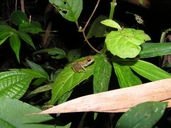|
Description
M 23-24 mm, F 24 mm. Tibiotarsal articulation reaches at least beyond the eye, sometimes slightly beyond snout tip. No webbing between fingers, a trace of webbing between toes. Inner metatarsal tubercle protruding, but smaller than in G. silvanus. Dorsal skin relatively smooth with a number of granules. Dorsally olive greenish to light brown with indistinct brown markings. Iris copper (Glaw and Vences 2007).
Distribution and Habitat
Country distribution from AmphibiaWeb's database: Madagascar
Anjanaharibe, forest near Andranofotsy, Marojejy (Glaw and Vences 2007). It occurs between sea level and 700m asl, in pristine rainforest (Stuart et al. 2008).
Life History, Abundance, Activity, and Special Behaviors
Habits: Active during the day among boulders in small rainforest streams. Males were observed calling during the day from hidden positions among such rocks (Glaw and Vences 2007). It is not known whether this species breeds by larval or direct development (Stuart et al. 2008).
Calls: A long series of short click notes, each repeated after short variable intervals (Glaw and Vences 2007).
Trends and Threats
Vulnerable. Considered locally abundant but decreasing. This species is found in three protected areas: Parc National de Marojejy, Parc National de Masoala, and Réserve Spéciale d’Anjanaharibe-Sud. It requires pristine rainforest. The main threat is habitat loss, due to subsistence agriculture and grazing, logging, charcoal manufacture, invasion and spread of eucalyptus, and expanding human settlement (Stuart et al. 2008). Possible reasons for amphibian decline General habitat alteration and loss
Habitat modification from deforestation, or logging related activities
Intensified agriculture or grazing
Comments
Taken with permission from Glaw and Vences (2007) and Stuart et al. (2008).
References
Glaw, F., and Vences, M. (2007). Field Guide to the Amphibians and Reptiles of Madagascar. Third Edition. Vences and Glaw Verlag, Köln.
Stuart, S., Hoffmann, M., Chanson, J., Cox, N., Berridge, R., Ramani, P., Young, B. (eds) (2008). Threatened Amphibians of the World. Lynx Edicions, IUCN, and Conservation International, Barcelona, Spain; Gland, Switzerland; and Arlington, Virginia, USA.
Originally submitted by: Miguel Vences and Frank Glaw (first posted 2009-03-31)
Edited by: Kellie Whittaker (2009-04-07)Species Account Citation: AmphibiaWeb 2009 Gephyromantis rivicola <https://amphibiaweb.org/species/5633> University of California, Berkeley, CA, USA. Accessed Mar 27, 2025.
Feedback or comments about this page.
Citation: AmphibiaWeb. 2025. <https://amphibiaweb.org> University of California, Berkeley, CA, USA. Accessed 27 Mar 2025.
AmphibiaWeb's policy on data use.
|
